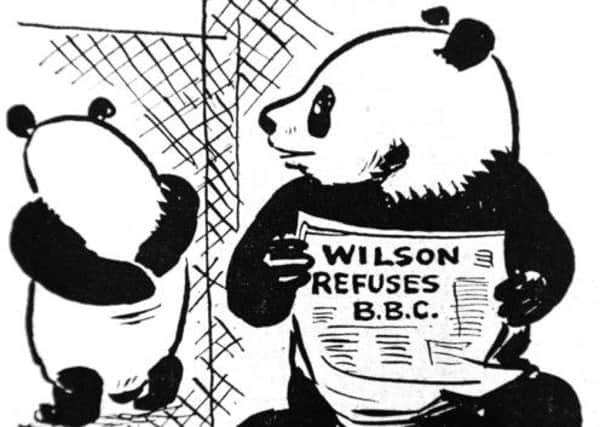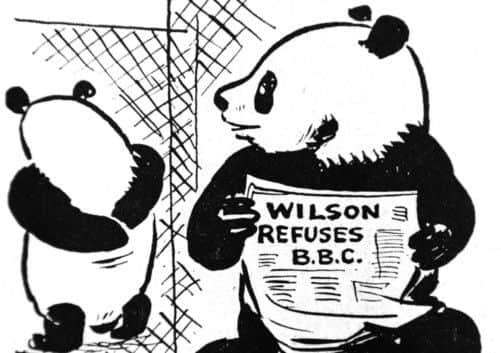Video: The Scotsman’s 1966 panda cartoons revisited


EAGERLY anticipating daily updates on fertility levels as we wait for giant pandas to mate might seem to be a typical fascination of the uninhibited, taboo-free 21st century, but as Tian Tian and Yang Guang start to feel the pressure of expectation mounting around their Edinburgh Zoo enclosure they could perhaps take comfort from the fact that such voyeurism is in fact the norm in these parts.
In March 1966, the UK was gripped by two simultaneous dramas: a general election which pitted Harold Wilson against Ted Heath, and an attempt to mate London Zoo’s giant panda, Chi Chi, with Russian male An An.
Advertisement
Hide AdAnd at The Scotsman, the pandas generated at least as much excitement as the ballot box, with a series of front-page cartoons by the newspaper’s famous caricaturist Emilio Coia, causing a stir by linking the two news stories.


The idea took off when the editor, Alastair Dunnet, remarked that the election campaign had been dull and wondered out loud if it could be livened up by the pandas. Gilbert Peddie, who worked in management services, came up with the answer. “I suggested a cartoon featuring the pandas in their separate cages with Chi Chi looking longingly at An An and a caption referring to a hot topic at the time,” explains Mr Peddie, now 83.
“Emilio Coia sketched the scene and it appeared on the front page. That must have been a first. We continued the theme for a week and it caused amusement with different scenarios. Each morning the BBC mentioned The Scotsman’s pandas.”
But alas, the pandas failed to mate after becoming so aggressive that they had to be separated. A further attempt in London two years later also drew a blank. And the election? It probably says a lot about the campaign that Mr Peddie recalls the outcome of the mating attempt, but has to think about the vote. Wilson won, by 96 seats.
“Good luck to today’s pandas,” says Mr Peddie. “As their own caption might say, ‘Scotland expects!’ ”
28 MARCH, 1966
The first panda cartoon in the series shows the bears still separated in their cages and gazing at each other longingly, so close but so far apart. The caption’s reference to an election issue over the power of the unions - doing away with restrictive practices to improve productivity - was a key debate of the political battle between Wilson and Heath and translated perfectly into the scenario the pandas faced at that stage.
29 MARCH, 1966
Advertisement
Hide Ad“The first panda cartoon was a hit,” says Gilbert Peddie, who wrote the caption, “but I didn’t expect to be asked the next day: ‘Right, what’s the caption for Day 2?’”
Again, the election narrative matched that of the pandas’ progress. The cages have gone and only a thin wire fence keeps them apart – just as opinion polls showed that there was not much between the two main parties, with the election only two days away.
30 MARCH, 1966
Advertisement
Hide Ad“Before we knew where we were it was day three,” says Mr Peddie. “When Roy Thomson bought The Scotsman in 1952, he was asked what he would do with the newspaper, and he replied: ‘I’m going to put funnies on the front.’ He was only joking, but here we were, doing just that.” By this stage, An An has been let loose, but Chi Chi is still caged. It’s a waiting game for Chi Chi, as it is for Mr Wilson to see if he will continue as Prime Minister.
31 MARCH, 1966
Trade union matters become the theme again - running parallel with the pandas’ own attempt at a different kind of union, as the bears get together at last. George Woodcock, mentioned in the caption, was the TUC leader in 1966. The political climate is reflected in the headlines on front-page stories, such as ‘Strikers at Linwood defy agreement’ and ‘Car delivery men end strike’, and ‘Press dispute ends’.
1 APRIL, 1966
“By day four we were on a roll,” says Mr Peddie. “I came up with each caption on my train journey into Edinburgh from Polmont every day. And I got a guinea a day for each one! In this one, An An has received a letter from the government. Because the bears had come from overseas, and the country was willing them to have an affair, the job offer of Minister of Foreign Affairs in the new government was a good fit.”
2 APRIL, 1966
It’s all over, and the consequences are sinking in. The election has been won and lost, and the pandas have tried and failed. The bears have been returned to their cages, and sit back-to-back with fences keeping them apart, looking disappointed. Meanwhile, Wilson has been returned to Downing Street with an increased majority following a poor result for the Tories, who now formed a weakened opposition.
5 APRIL, 1966
The final frame reflects on a spat between Mr Wilson and the BBC, which made headlines following an allegation that Association of Broadcasting Staff members show political bias in BBC programmes. An An holds a newspaper which declares: ‘Wilson refuses BBC’ just as Chi Chi has turned her back on him, having refused his advances. “The series was fun,” says Mr Peddie. “Happy memories all these years later.”